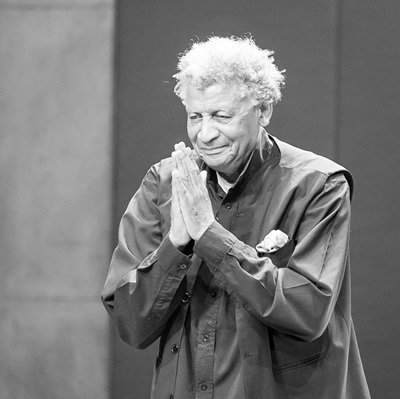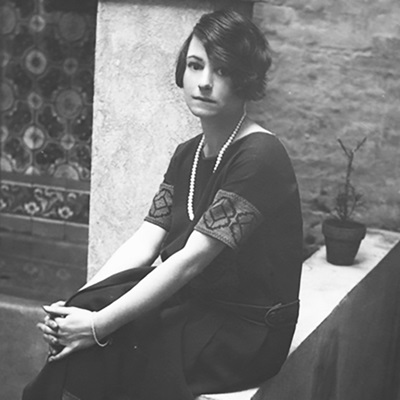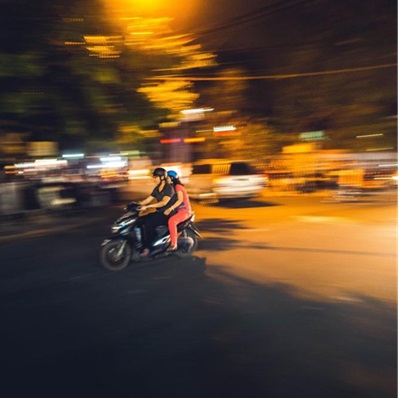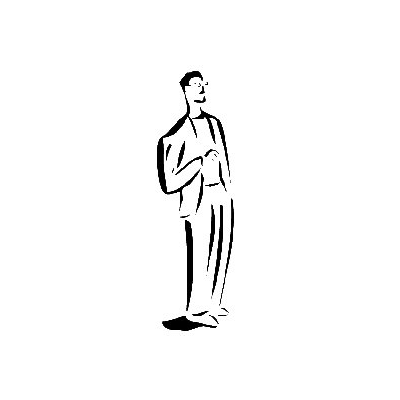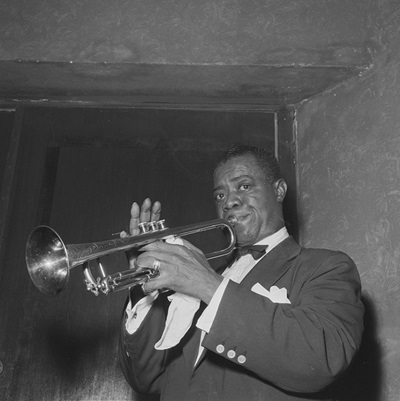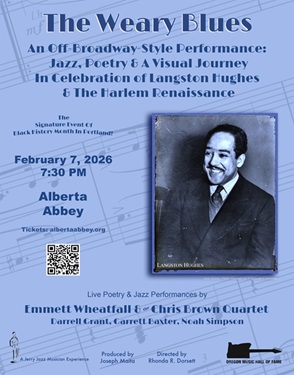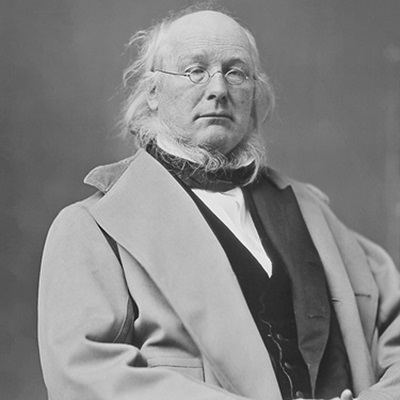Jazz: Through the Life and Lens of Milt
Hinton
*
Photo from the Hinton Family Collection
Milt Hinton, c. 1941
.
_____
.
…..Since its inception in 1997, it has been the goal of Jerry Jazz Musician to publish content that connects jazz music and American civilization, and to present the culture of the music to readers in a way that will spark memories for the generation who lived during its “golden age,” and help nourish curiosity about it to members of generations who did not.
…..As a jazz musician for seven decades, and as a chronicler of its intellectual and spiritual development through his fascinating, award-winning photography, Milt Hinton acts as an essential connecting point for the music and its associated culture. Hinton played bass alongside iconic figures like Cab Calloway, Dizzy Gillespie, and Louis Armstrong, and, as a photographer, brought these men and a host of others into focus as musicians, artists, and vital contributors to twentieth-century American life.
…..TThis post originally appeared in 2006, with the generous consent of David G. Berger and Holly Maxson, who along with Milt Hinton co-authored Playing the Changes: Milt Hinton’s Life in Stories and Photographs, Jerry Jazz Musician presents a photo exhibit, “Jazz: Through the Life and Lens of Milt Hinton.”
The exhibit consists of two parts:
The Life of Milt Hinton
— A chronicle of Hinton’s career as a musician and photographer, featuring photographs of and by Hinton, as well as book excerpts and an introduction by Clint Eastwood, and;
The
Photography of Milt Hinton
— Featuring photographs taken by Hinton, as well as book excerpts
.
.
The photographs and the stories within this exhibit are just a small sampling of Hinton’s career.
At the conclusion of this feature, we have published updated information about Mr. Hinton’s work, the news of which was provided by David Berger
*
.
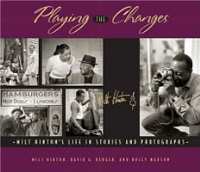
All photos and book excerpts from
Playing
the Changes: Milt Hinton’s Life in Stories and Photographs, by Milt Hinton, David G. Berger, and Holly Maxson, published by
Vanderbilt University
Press. Copyright (c) 2008 by Milton J. Hinton Photographic Collection.
All rights reserved.
___________________________
Introduction
(Excerpted from the book’s Foreword)
Milt Hinton is a unique figure in jazz. As a bass player, he spans seven decades of the music’s history. Starting out with Cab Calloway in 1936, he soon became one of jazz’s essential sidemen, performing on what are now classic recordings with the likes of Benny Goodman, Lionel Hampton, Coleman Hawkins, Billie Holiday, and Ben Webster. And with some help from Jackie Gleason, he became one of the first black musicians to integrate the recording studios in the early ’50’s, backing up legends like Frank Sinatra, Bing Crosby, and Barbara Streisand.
What also makes Milt Hinton’s life so wonderful is his photographic work. He got a new camera in the late ’30s and began shooting his fellow musicians and the places he traveled. What he recorded provides valuable insights into why jazz is one of America’s great art forms.
I was deeply touched when my son Kyle, a jazz bassist, was asked to perform at a concert celebrating Milt’s ninetieth birthday at the JVC Festival in 2000. Having Kyle play in a bass chorus with some of jazz’s finest musicians made me proud and reaffirmed my passion for the music.
Milt Hinton’s body of work has inspired and guided me in my musical journey, and I think Playing the Changes: Milt Hinton’s Life in Stories and Photographs will provide a similar experience for all who have loved jazz as I have throughout my life.
– Clint Eastwood, April, 2007
.
*
.
Part One:
The Life of Milt Hinton
|
Photo from the Hinton Family Collection
Hilda Gertrude Robinson (“Titter,” Milt’s mother) and Milton John Hilton (“Milt”), Vicksburg, Mississippi, c. 1911 * “From my birth until I left Mississippi when I was nine, I lived in Vicksburg with my mother, two of her sisters — my aunts Pearl and Alberta — and Mama [Milt’s maternal grandmother]. So three of Mama’s children were living under one roof and two others — my uncles Bob and Matt — were still alive at the time I was born. Uncle Matt lived somewhere else in town, but Uncle Bob had gone up to Chicago a couple of months after I was born. My mother never did have any more children and my aunts never had kids.” – Milt Hinton |
|
|
Photo from the Hinton Family Collection
Milt, Vicksburg, Mississippi, 1913 * “I also went to regular public school in Vicksburg. I don’t think I learned very much there because a few years later, when we moved to Chicago, they put me back a couple of grades. What I remember best is stopping on the way to school and buying a can of condensed milk for a nickel. I’d take it into the classroom, put a hole in the can, and set it under my desk. I kept a wooden clothespin in my drawer and I’d stick it in the can and let the milk absorb into the wood. Then I’d suck it until the sweet taste was gone, dip it back in the can, and start over again. I had it worked out so the little can lasted all day.” – Milt Hinton |
|
|
Photo from the Hinton Family Collection
Milt, Vicksburg, Mississippi, c. 1919 * [The six o’clock train to Chicago]…”was my first time on a train. We were in the black coach, of course, and it was crowded and unbelievably dirty. It smelled like rotten food and it was noisy. It was hard to fall asleep and the trip seemed like it went on for days. “We got to Chicago sometime late the next day, and my mother and my aunt and uncles were right there to meet us. It was October or November, and it was pretty cold in Chicago. My mother had brought a coat to the station for me and put it on me the moment we arrived. Then we all got into a taxicab and went to my new home.” – Milt Hinton |
|
|
Photo from the Hinton Family Collection
Milt, Chicago, c. 1922 * “A couple of days after we arrived in Chicago, Mama took me over to the Doolittle Grammar School at 36th and Cottage Grove, a block or two from where we lived. It was a beautiful red brick building with a large playground surrounding it — I’d never seen a school like that in Mississippi. They gave me some kind of test so they could put me in the right grade. I’d just finished fifth grade in Vicksburg, so I cried when I found out I’d have to go back and repeat three grades at Doolittle. That’s how different the education was for blacks in the North and South in those days…. “…music came to mean more to me than anything else. I started playing the violin at thirteen and from that point on, whenever something bad happened, I’d go off alone and play my music. It became my religion. It was my salvation and it sustained me.” – Milt Hinton |
|
|
Photo from the Hinton Family Collection
Ed Burke and Milt, Chicago, 1923 * “Starting from the time I came to Chicago in 1919, I’d spend my Sunday afternoons seeing a live show and a silent movie at one of the theaters. Dave Peyton had the orchestra at the Grand Theatre with musicians like Oscar Low on sax, a trumpet player named Raymond Whitsett, and Jimmy Bell on violin. I liked Erskine Tate’s Orchestra at the Vendome much better. I think he had that job for about ten years and at one time or another he must’ve brought in every good musician around Chicago. I’d see Teddy Weatherford playing piano, the great clarinet player Barney Bigard, and a percussionist named Jimmy Bertrand. I remember we’d sit there in amazement when he’d play the melody to a blues called “My Daddy Rocks Me” on tympani. Evidently, in those days he was about the only black guy around who could play all the percussion instruments, and I’ve heard he’s the one who taught Lionel Hampton about xylophone… “Then there was Eddie South, one of the stars and a marvelous violin soloist. I loved him from the start. He was my inspiration and idol. Whenever I saw him, I knew what I wanted to be when I got older. I really worshipped him.” – Milt Hinton
|
|
|
Photo from the Hinton Family Collection
Wendell Phillips High School Symphony Orchestra: Milt (front row, sixth from left), Chicago, 1929 * “Other than my experiences with music and musicians, I don’t remember many things about Wendell Phillips [High School]. “…After a couple of years, some of the best musicians graduated and I had more seniority. Bill Lyle replaced Quinn Wilson as first chair in our symphony orchestra and when he graduated, it was finally my turn. Pretty soon I became president of the symphony. I was also made director of the booster orchestra, which played for dances and proms and during the intermissions at assemblies when they showed silent movies. I was getting to be one of the school’s musical stars.” – Milt Hinton |
|
|
Photo from the Hinton Family Collection
Wendell Phillips High School ROTC Marching Band: Milt with tuba (back row, far left), Chicago, 1929 * “I also made the All City Orchestra, which was made up of the best musicians from the twenty-three Chicago high schools — both black and white. Most kids had to wait until they were seniors to get in, but I made it for three years straight and got bronze, silver, and gold medals. Actually, the first two years I played violin, but by the third year I’d made the switch over to bass.” – Milt Hinton
|
|
|
Photo from the Hinton Family Collection
Milt, Chicago, c. 1929 * “I got my first steady job in the spring of 1930, about three or four months after I graduated from high school in January and had just started Crane [Junior College]. The leader was Tiny Parham, a piano player who must’ve weighed four hundred pounds. We had Delbert Bright, sort of an Earl Bostic-type saxophone player, and Freddie Williams, who sang and played guitar and banjo. Freddie had a short leg, so he wore a built-up shoe. Then there was Jimmy McHendrick on drums, and I played tuba.” – Milt Hinton |
|
|
Photo from the Hinton Family Collection
Milt, Chicago, c. 1930 * “In the spring of 1931, I got offered a steady job with Jabbo [Smith] at the Showboat on Clark Street, downtown. It was the last place Louis Armstrong worked before he left for New York. “…Because of Louis, the club had developed a reputation as a trumpet room, so when he left, they decided they had to find a suitable replacement and the closest they could get was Jabbo Smith.” – Milt Hinton
|
|
|
Photo from the Hinton Family Collection
Mr. and Mrs. Eddie South, Chicago, c. 1933 * “Playing with him [Eddie South] was one of the greatest challenges of my life. It was also about the best learning experiences I ever had. As a teenager, I’d idolized him, and having the opportunity to know him, hear him, and study him closely was a dream come true… “Once I spent an afternoon visiting Eddie at his place. Just before I left, he gave me a gift. He’d just gotten a new violin case and wanted me to have his old one. It wasn’t much to look at. It was made of alligator skin, but he’d used it so long it was practically worn out. None of that mattered, because when I opened it, I found a note written in longhand.
It was the most meaningful thing he could have given me, and I’ve always felt it was his way of telling me about the special place I had in his life.” – Milt Hinton
|
|
|
Photo from the Hinton Family Collection
The Cab Calloway Orchestra, c. 1936 * “Here’s how I got the [Cab Calloway Orchestra] job. In 1935, Cab went to California to make a movie called The Singing Kid with Al Jolson. When he left, Al Morgan was his bass player, but by the time they finished shooting, Al had quit and remained in California. From what I heard, he was so photogenic that some of the movie people told him they’d use him in other pictures if he stayed on the Coast. So he managed to join Les Hite’s band, which had steady work at the Cotton Club out there, and that made him available. “Al’s leaving took Cab by surprise. The movie was finished, and Cab was about to start working his way back east. Suddenly he had no bass player. “At that point, [trombonist] Keg [Johnson] recommended me to Cab. Much later, I heard how Cab reacted to the suggestion. he told Keg, ‘Look, if I can get to New York, I’ll get me a good bass player. But I got a lot of work to do before we get there. So when we hit Chicago, I’ll drop by and hear this kid.” – Milt Hinton
|
|
|
Photo from the Hinton Family Collection
The Calloway rhythm section (clockwise from top right): Leroy Maxey, Milt, Benny Payne, and Morris White, c. 1937 _____
|
|
|
Photograph taken with Milt Hinton’s camera and copyrighted by the Milton J. Hinton Photographic Collection
Milt, Cab Calloway bandstand, Dallas, c. 1937 * “When I was a kid they called me “Sporty.” I don’t know why — I wasn’t that sharp a guy, but it stuck with me even after I joined Cab. When I’d been with the band for a couple of years, I got a new nickname which came from a joke I used to tell all the time. I’d ask, “What’s the lowest thing on earth?” and wait to get a few answers. Then I’d s ay, ‘Fump!’ “‘Fump, what’s that?’ everybody’d ask. “And I’d answer, ‘Whale shit at the bottom of the ocean!’ “The joke sounds pretty corny today, but the name ‘Fump’ stuck with me for at least a dozen years.” – Milt Hinton
|
|
|
Photo from the Hinton Family Collection
Cozy Cole, Cab Calloway, Milt, and Stranth Washington, the E-Z Club, Washington, D.C., 1941 * “We had only one star in our band — Cab. And he wasn’t very interested in music. All he really ever wanted from us was solid accompaniment. But he paid better than Duke [Ellington] and he also seemed more concerned about developing discipline and making sure we had a positive image of ourselves.” – Milt Hinton
|
|
|
Photo Copyright by the Milton J. Hinton Photographic Collection
Paul Webster and Milt, Harlem, New York City, c. 1941 * “I developed a real fondness for Harlem. I still remember how, when the weather was warm, some of us would walk from the Cotton Club at 48th and Broadway up to the places where we were staying in Harlem. We’d been playing in a smoke-filled room all night, so when four AM rolled around, we looked forward to getting some fresh air. “There were usually five or six of us. We’d head up toward Central Park West and then follow it north all the way to Harlem. There was a great bakery on 116th, and we’d stop there and pick up a couple of dozen donuts or some fresh rolls. Then we’d get a couple quarts of milk, spread everything out on a park bench, and pass the food around. When we were finished, we’d go our separate ways.” – Milt Hinton
|
|
|
Photo from the Hinton Family Collection
Milt Hinton, c. 1941
|
|
|
Photo Copyright by the Milton J. Hinton Photographic Collection
Danny Barker and Dizzy Gillespie, train, c. 1940 * “There was a system to traveling on the road. We’d put on bathrobes and hang around our berths waiting for a turn in the bathroom. After each guy washed and shaved, he’d go to his big H & M trunk in the baggage car, take out a clean suit, go back to the Pullman, and get dressed. We would usually spend the rest of the afternoon in the dining car and then back in the Pullman hanging out, reading, talking, or playing cards.” – Milt Hinton
|
|
|
Photo from the Hinton Family Collection
Milt and Cozy Cole, Panther Room, Hotel Sherman, Chicago, 1941 * “In his own way, Cab was concerned about race. He didn’t want to present black people in a stereotyped, Uncle Tom image, especially in the Deep South. So when we went down there he’d make sure to emphasize a high class presentation. He’d take performers like Honi Coles, Avis Andrews, and the Mills Brothers with him, and he’d make sure everyone dressed and acted properly, both on and off the stage. In his own way, he emphasized the dignity of black people.” – Milt Hinton
|
|
|
Photograph taken with Milt Hinton’s camera and copyrighted by the Milton J. Hinton Photographic Collection
Jackie Gleason and Milt, New York City, 1952 * “It was Jackie Gleason who really helped me get started in another part of the music business — studio work. “I first met Jackie sometime during my last years with Cab. Back in those days, he was a struggling comedian who got his best laughs — sometimes his only laughs — from the band. He loved jazz and always like to hang out with musicians, who are known for their generosity, especially when it comes to buying drinks. “It was during my slow period that I ran into Jackie and his manager, Bullets Durgom, on a street corner downtown. I knew Bullets from the old days when he was a song plugger. Whenever we played New York, he’d bring Cab material and try to get it on the air. I hadn’t seen Jackie for a while, and by this time he was a celebrity. He asked me the usual kinds of questions: ‘Whatta ya doing? What’s going on?’ “But instead of giving the standard show-business answer, I told the truth and said, ‘Nothing.’ “Hearing that, Jackie turned to Bullets and said, ‘We’re doin’ a record date tomorrow. Put Milt on it.’ “Bullets didn’t know what to say. He tried to explain about contractors and hiring, but Jackie didn’t want to know. “‘I don’t give a damn about the contractor. Call whoever’s in charge and tell him I want Milt there tomorrow,’ Jackie said. “‘But Jackie, we already have a bass player,’ Bullets argued. “And I’ll never forget Jackie’s answer, ‘Well, now we have two.'” – Milt Hinton
|
|
|
Photo Copyright by the Milton J. Hinton Photographic Collection
Count Basie, television studio (Sound of Jazz rehearsal), New York City, 1957 * “I continued working wherever and whenever I could and then I got a job offer I never expected — a chance to work with [Count] Basie… “Basie wouldn’t let me get bored. Onstage we’d always be a couple of feet apart and he’d kid with me all night. If we were playing up-tempo and I was walking fast and starting to sweat, he’d tinkle a couple of notes, then lean over to me and say, ‘Go ahead, hog, you’re gonna take it anyway.’ I always broke up.” – Milt Hinton _____
|
|
|
Photo Copyright by the Milton J. Hinton Photographic Collection
Louis and Lucille Armstrong, Honolulu, 1954 * “Deciding whether or not to go with Louis was very difficult. My month-long commitment to Basie was over, but I was getting good freelance jobs. And even though I couldn’t be sure how much I’d be making from week to week, the pay was getting better. When I left Cab, I said I’d never go back on the road any length of time, but the thought of playing with a legend like Louis made the idea of traveling more acceptable.” – Milt Hinton
|
|
|
Photograph taken with Milt Hinton’s camera and copyrighted by the Milton J. Hinton Photographic Collection
Milt and Duke Ellington, Yale University, New Haven, Connecticut, 1972 * “Duke [Ellington] called me one night and asked if I’d come down to the Rainbow Grill that night and sub for Joe Benjamin. I jumped at the opportunity… “…we began to take our places on the bandstand. I still hadn’t seen Duke and I didn’t know what the hell I was supposed to play. I was really on edge. “As soon as I got on the stand, I spotted Duke sitting with some guests at one of the front tables. The band wasn’t ready, so I put my bass down and walked over to him. He got up from the table, greeted me with his usual ‘Hello, baby,’ and kissed me on both cheeks, the way he always did. I must’ve seemed nervous when I asked about the first tune, but he was very calm. ‘You just cantor in F ’til I bring the band in.’ “I knew what he wanted immediately. Cantoring is a vamp which gets its name from Eddie Cantor’s old radio show. His audience used to chant the same four notes over and over, saying, ‘We want Cantor.’ I felt more relaxed. “I went back to the stand, everyone took their places, and a few minutes later Duke joined us. Then he counted off, pointed to me, and I began. About thirty seconds later the whole band hit and then I was totally confused. I didn’t know the changes. There was no guitar, and since Duke wasn’t seated at the piano, I couldn’t watch his left hand to get my notes. Trying to find changes by listening to the brass and reeds is an uphill battle. “Duke could tell I was struggling. He looked in my direction until he was sure he’d caught my eye. Then he pointed one finger to his ear, as if to say, ‘Relax and listen, baby, you’ll hear it.’ I did. I followed the best way I knew, and I survived. “Duke praised me all during the evening. He introduced me to the audience and told them how I’d come in at the last minute to help him out. But the greatest compliment came in a letter I got about a week later. It was from a Canadian priest. He’d been one of Duke’s guests the night I played. He said that at one point during the evening, Duke talked to him about me and told him, ‘He looks like a king up there on the stand, doing all those miraculous things. He plays like he’s been here all the time.'” – Milt Hinton
|
|
|
Photo Copyright by the Milton J. Hinton Photographic Collection
Jo Jones, recording studio, New York City, c. 1972 * “I learned a tremendous amount about pitch and sound from [drummer] Jo [Jones]. He could drive a band harder, louder, and better than anyone, but he also knew about using the drums to speak softly. His brushwork was something to behold. He showed us that you don’t have to be loud to be heard. If you’re good enough, people make it their business to listen.” – Milt Hinton
|
|
|
Photo Copyright by the Milton J. Hinton Photographic Collection
Louie Bellson and Pearl Bailey, on tour in the Middle East, United Arab Emirates, 1979 * “Some of my favorite foreign trips were with Pearl Bailey in the ’70s and ’80s… “…some of my fondest memories come from the first trip we made to the Middle East in the early ’70s. Her husband Louie Bellson, was the drummer, and Don Abney was her pianist. This was a good will tour sponsored by the State Department. As I recall, we were about a week ahead of President Nixon, who was scheduled to make official visits to the same countries. We never played for the public, but we met a lot of foreign dignitaries and officials from our State Department.” – Milt Hinton |
|
|
Photograph taken with Milt Hinton’s camera and copyrighted by the Milton J. Hinton Photographic Collection
Milt and Jane Jarvis, Zinno Restaurant, New York City, 1986 * “In addition to traveling, beginning in the early ’70s, I found myself working at a few jazz clubs around the city… “From the mid ’70s until the mid ’90s, once or twice a year I’d also take a gig with an all-star group and play at one of the major jazz clubs in the city. But, aside from Michael’s Pub, the other places I worked were usually small and less known.” – Milt Hinton
|
|
|
Photograph taken with Milt Hinton’s camera and copyrighted by the Milton J. Hinton Photographic Collection
Milt Hinton, television studio, New York City, c. 1968 * “Over the years, I played concerts with hundreds of performers from just about every era of jazz. Truthfully, it really didn’t matter who I was with or what the gig required, just as long as I could play the music I truly love.” – Milt Hinton
|
.
.
Part two of “Jazz: Through the Life and Lens of Milt Hinton”:
The Photography of Milt Hinton
.
_____
.
.

All photos and book excerpts from Playing the Changes: Milt Hinton’s Life in Stories and Photographs, by Milt Hinton, David G. Berger, and Holly Maxson, published by Vanderbilt University Press. Copyright (c) 2008 by Milton J. Hinton Photographic Collection. All rights reserved.
Part Two:
The Photography of Milt Hinton
.
*
.
Photo copyright Robert Appleton
Milt Hinton, Hartford, Connecticut, 1990
_____
The black-and-white photographs taken by Milt Hinton between 1935 and 1999 comprise the major part of the Milton J. Hinton Photographic Collection, which is housed in New York City. The collection, co-directed by David G. Berger and Holly Maxson, contains approximately sixty thousand 35 mm negatives, thousands of reference and exhibition-quality prints, and photographs given to and collected by Milt throughout his life.
Photographs from the collection have appeared in books, periodicals, newspapers, jazz calendars, postcards, CD art, films, in videos, and on the Internet.
The collection has curated exhibition at venues ranging from neighborhood community centers to museums, including the Corcoran Gallery of Art, the Denver Art Museum, and the Smithsonian Institution.
Until Milt’s death in 2000, the management of the collection — selecting negatives for reference and exhibition prints, monitoring print quality, and choosing exhibition sites — involved a close collaborative effort between Milt, David, and Holly. In their continuing administration of the collection, David and Holly are always mindful of Milt’s point of view as a documentarian, his aesthetic, and his “voice.”
Milt was never a professional photographer, and he readily acknowledged that many of his pictures are of dubious quality. He rarely used a flash in low-light situations, and to be less obtrusive, he often preset the camera’s focus so he could literally shoot from the hip. Many rolls of film remained undeveloped for twenty years, and because Milt was
seldom in the darkroom, at times he inadvertently used stale chemicals to process his film. Negatives remained paper-clipped to contact sheets for years, which resulted in rust problems, and several basement floods caused many to adhere to one another and to their paper sleeves.
A current and major goal of the collection is to complete a database of Milt’s photographs. This on-going project, begun in the late 1990s, in recent years has benefited from advances in digital photography. Scanning has become faster and more accurate, and digital storage is less expensive. Computer software allows a trained user to restore a damaged negative or print and to retrieve elusive details from poor-quality images while maintaining the integrity of the photographs. The success of digital processing is clearly visible in the 2002 Berger and Maxson documentary film, Keeping Time: The Life, Music & Photographs of Milt Hinton, and in some of the photographs that appear in their book Playing the Changes: Milt Hinton’s Life in Stories and Photographs as well.
– From Playing
the Changes: Milt Hinton’s Life in Stories and Photographs, by Milt Hinton, David G. Berger, and Holly Maxson
.
_____
.
Additional information and a current listing of shows can be found at
www.MiltHinton.com
.
.
|
Photo Copyright by the Milton J. Hinton Photographic
Danny Barker, Hot Lips Page (foreground) and other patrons including Barney Bigard, Willie “The Lion” Smith, Claude Jones, and Wellman Braud, Beefsteak Charlie’s, New York City, c. 1954 * “After the two books with my photographs came out, people got more interested in them than ever before. I had shows at places like Rhode Island School of Design and the Denver Art Museum, which I’ve been told are very prestigious. – Milt Hinton |
|
Photo Copyright by the Milton J. Hinton Photographic
Louis and Lucille Armstrong, Honolulu, 1954 |
|
Photo Copyright by the Milton J. Hinton Photographic
Count Basie and Duke Ellington, recording studio, New York City, * “To call Milt Hinton a historian is not stretching the term. He may not always have been conscious of this role, but his ability to listen, to ask key questions, and to remember well was there almost from the start.” – Jazz critic Dan Morgenstern
|
|
Photo Copyright by the Milton J. Hinton Photographic
Eubie Blake, concert (25th Anniversary of the Newport Jazz Festival),
|
|
Photo Copyright by the Milton J. Hinton Photographic
Dizzy Gillespie, Chu Berry, and Butter Jackson, Fox Theater, Detroit, * “When I first started out in the ’30s, I took pictures so I could show my family and friends that I’d really been to all those places and knew all those people. Several years later, the guys I was traveling with became my friends and I shot things we all experienced so we could share them later.” – Milt Hinton |
|
Photo Copyright by the Milton J. Hinton Photographic
Cab Calloway with a winner of the Cab Calloway Quizzicale radio show, * “I got my first camera in 1935. It was a 35 mm Argus C3, and it was a present for my twenty-fifth birthday. I had the Argus with me when I started on the road with Cab in 1936. Although I took a few posed shots, I was never much for taking formal pictures. Everybody was shooting the band onstage in uniform, and if you went to a professional – Milt Hinton |
|
Photo Copyright by the Milton J. Hinton Photographic
Johnny Hodges, Beefsteak Charlie’s, New York City, c. 1960 |
|
Photo Copyright by the Milton J. Hinton Photographic
Herb Flemming and Sonny Greer, Beefsteak Charlies, New York * “[Hinton’s] sense of history…also led to Milt’s taking up photography, still another way of documenting and preserving the past for the present and future. Even the earliest photos…demonstrate his talent for composition within the frame, his skills as an observer, and his perfect sense of timing — the latter a gift surely akin to his mastery of jazz – Jazz critic Dan Morgenstern
|
|
Photo Copyright by the Milton J. Hinton Photographic
Louis Armstrong, hotel room, Seattle, 1954
|
|
Photo Copyright by the Milton J. Hinton Photographic
Dizzy Gillespie, the Palace Theater, Cleveland, 1939 * “I still get asked why I took some of the pictures I did, and it’s hard to answer that question. When I took those early pictures of Dizzy, we were both in Cab’s band. Even back in those days, I knew he was very innovative, but I never suspected he would turn out to be such a giant. The same thing was true for Chu [Berry] and Cozy [Cole] and the other guys. These were my friends, and I wanted pictures of them so that one day we could look back and remember the great times we shared.” – Milt Hinton |
|
Photo Copyright by the Milton J. Hinton Photographic
Danny Barker and Dizzy Gillespie, train, c. 1940 * “I always tried to capture something different. Whenever possible, I liked to shoot people when they were off guard or unaware. Of course, I was limited in some ways. I didn’t have a flash in the early days, and the film speed was so slow you couldn’t take photographs indoors without using a long exposure. Even so, I did get some unusual shots inside, like pictures of the guys sleeping on the train. There were also times when the stage lights were on and I could use them to get a better indoor exposure.” – Milt Hinton
|
|
Photo Copyright by the Milton J. Hinton Photographic
Chu Berry, unknown, Danny Barker, and Lammar Wright, Durham, North Carolina, c. 1940 |
|
Photo Copyright by the Milton J. Hinton Photographic
Art Farmer, unknown, John Coltrane, Bill Evans, and Bob Brookmeyer, recording studio, New York City, 1958 * “At some point, probably in the late ’40s, I saw that jazz was changing quickly and there were new faces coming on the scene all the time. Some of the pioneers like Chu [Berry] and Jimmy Blanton were already gone, and some of the other greats were well on their way to early deaths. For some reason, I felt strongly about using my camera to capture people and events from the jazz world that I was lucky enough to see. I guess I realized I was actually living through jazz history.” – Milt Hinton |
|
Photo Copyright by the Milton J. Hinton Photographic
J.J. Johnson, Osie Johnson and Miles Davis, recording studio, New York City, c. 1956
|
|
Photo Copyright by the Milton J. Hinton Photographic
Wynton Marsalis and Branford Marsalis, classroom, New Orleans, c. 1978 |
|
Photo Copyright by the Milton J. Hinton Photographic
Teddy Wilson, recording studio, New York City, c. 1955 * “By the time I was playing in the studios regularly, I had one or two cameras with me all the time. Record companies had great professional photographers come in and shoot sessions, but they kept a close watch on these guys. They’d usually let them in at the beginning and end of a date, or during five-minute breaks. Sometimes I’d see a makeup artist work on a performer for an hour and someone else setting up a background to stage a candid shot. Of course, as a musician hired to play, I could get pictures whenever I wanted. During all those years, I don’t remember anyone ever trying to stop me.” – Milt Hinton |
|
Photo Copyright by the Milton J. Hinton Photographic
Aretha Franklin, recording studio, New York City, c. 1961 |
|
Photo Copyright by the Milton J. Hinton Photographic
Cannonball Adderley, recording studio, New York City, c. 1958 |
|
Photo Copyright by the Milton J. Hinton Photographic
Ernie Wilkins, Kenny Drew (at the piano), and Dinah Washington, recording studio, New York City, c. 1956 |
|
Photo Copyright by the Milton J. Hinton Photographic
Lester Young, television studio (Sound of Jazz rehearsal), * “I’m…pleased about some of the pictures I got at the Sound of Jazz television show. As far as I’m concerned, this was one of the best programs ever done on jazz. I got photos of Basie, Billie, Prez, Bean and many others. I know you can get the program on videotape and I’ve seen it a dozen times. But photos are different. You can study them. You can analyze the expressions on people’s faces, and to my way of thinking, you can see what they’re really all about. That’s one thing which always attracted me to photography.” – Milt Hinton |
|
Photo Copyright by the Milton J. Hinton Photographic
Billie Holiday and Count Basie, television studio (Sound of Jazz rehearsal), New York City, 1957
|
|
Photo Copyright by the Milton J. Hinton Photographic
Thelonious Monk, Ahmed Abdul-Malik, and Count Basie; television studio (Sound of Jazz rehearsal), New York City, 1957
|
|
Photo Copyright by the Milton J. Hinton Photographic
Benny Goodman, concert rehearsal, New York City, c. 1956 * “During my days in the studios, whenever I had time, I’d make a few black-and-white prints from what I’d shot a day or two earlier. Then I’d give them out to the guys the next time I saw them on a record date. Although it was unintentional, the prints I made of my white friends always came out looking very dark. And whenever someone teased me about it, I’d say the same thing: ‘I can’t help it, that’s just the way I see everybody.'” – Milt Hinton
|
|
Photo Copyright by the Milton J. Hinton Photographic
Ben Webster, Beefsteak Charlie’s, New York City, c. 1960 * |
|
Photo Copyright by the Milton J. Hinton Photographic
Jimmy Rushing, concert, Forest Hills, Queens, New York City,
|
|
Photo Copyright by the Milton J. Hinton Photographic
Willie “The Lion” Smith and Eubie Blake, backstage, Newport Jazz Festival,
|
|
Photo Copyright by the Milton J. Hinton Photographic
Lester Young and J.C. Heard, Esquire magazine photo shoot, * “In 1958, Esquire magazine invited practically every living jazz musician to pose for a picture up in Harlem… “I don’t think the Esquire people had any idea about the importance of the gathering. All they seemed to want was a perfect shot of the whole group posed on the stoop of a brownstone…. “Fortunately, I had enough sense to bring [three cameras]…“ – Milt Hinton |
|
Photo Copyright by the Milton J. Hinton Photographic
Front row: George Wettling and Bud Freeman; Second row: Jo Jones, Gene Krupa, Sonny Greer; Third row: Miff Mole, Zutty Singleton, and Red Allen; Fourth row: Dickie Wells, Art Blakey and Taft Jordan; Top row: Buck Clayton, Benny Golson, Art Farmer, and Hilton Jefferson, Esquire magazine photo shoot, Harlem, New York City, 1958 * “The shot I got that day of some of the greatest drummers in jazz is one of my favorites. Just being able to capture Jo Jones, Gene Krupa, George Wettling, Zutty Singleton, Sonny Greer, and Art Blakey all together was the chance of a lifetime.” – Milt Hinton |
|
Photo Copyright by the Milton J. Hinton Photographic
Billie Holiday, recording studio (her last recording session), New York City, 1959 * “…very few [jazz photographers] were privy to so many informal shooting opportunities as Milt, who manifests a trait rare to photographers — discretion. – Jazz critic Dan Morgenstern
|
|
Photo Copyright by the Milton J. Hinton Photographic
Billie Holiday, recording studio (her last recording session), New York City, 1959 * “I get asked most often about the shots I took of Billie Holiday at what turned out to be her last recording session. I had the feeling she was close to the end. I think the record company people knew exactly what was going on and were trying to finish the album while she was still on her feet.” – Milt Hinton |
|
Photo Copyright by the Milton J. Hinton Photographic
Beefsteak Charlie’s patrons include Art Blakey, Tyree Glenn, Catherine Basie, and Illinois Jacquet, New York City, 1958 * “[Hinton was] a tolerant man, but he cannot stand deviousness, and, being an honest man, he has always stood up for his own rights and for others’ as well. Such unfashionable virtues as self-respect and respect for others have contributed greatly to Milt Hinton’s success in life and music — combined, of course, with exceptional talent and a willingness to face professional challenges.” – Jazz critic Dan Morgenstern
|
|
Photo Copyright by the Milton J. Hinton Photographic
Quincy Jones, recording studio, New York City, c. 1959 |
|
Photo Copyright by the Milton J. Hinton Photographic
Mary Lou Williams, Yale University, New Haven, c. 1972
|
|
Photo Copyright by the Milton J. Hinton Photographic
Sarah Vaughan, Pearl Bailey, and Ella Fitzgerald, rehearsal, television
|
|
Photo Copyright by the Milton J. Hinton Photographic
Dizzy Gillespie, Grande Parde du Jazz, Nice, France, c. 1981 * “When I look back at where I’ve come from, I still can’t believe how things have turned out — what I’ve experienced in almost nine decades on this earth, and how lucky I’ve been.” – Milt Hinton
|
.
.
_____
.
.

All photos and book excerpts from
Playing
the Changes: Milt Hinton’s Life in Stories and Photographs, by Milt Hinton, David G. Berger, and Holly Maxson, published by
Vanderbilt University
Press. Copyright (c) 2008 by Milton J. Hinton Photographic Collection.
All rights reserved.
.
.
.
Updated information about Mr. Hinton’s work, the news of which was provided by David Berger.
.
Milt and Mona Hinton’s papers including personal correspondence, contracts, Milt’s datebooks, family photographs, and ephemera are in the Special Collections Library at the Oberlin Conservatory in Oberlin, OH. Oberlin is planning to digitize some of these materials and make them available on the web. http://www2.oberlin.edu/library/cons/special/hinton.html
Over the past five years, Milt Hinton’s photographs have been gifted to the Allen Memorial Art Museum, Oberlin, OH; the Yale University Art Gallery, New Haven, CT; the Museum of the City of New York; the New York Public Library (Main Branch); and the Museum of Contemporary Photography, Columbia College, Chicago, IL.
A travelling exhibit that includes ten display panels documenting Milt Hinton’s life, and fifty framed original Hinton photographs is currently touring Historically Black Colleges and Universities. https://www.oberlin.edu/about-oberlin/libraries-and-collections/milt-hinton
Oberlin Conservatory sponsors the Milt Hinton Institute for Studio Bass, a week-long program offered every two years in July for teenage students who are mentored by renowned classical and jazz musicians. https://www.oberlin.edu/summer-programs/hinton-bass-institute
.
.






